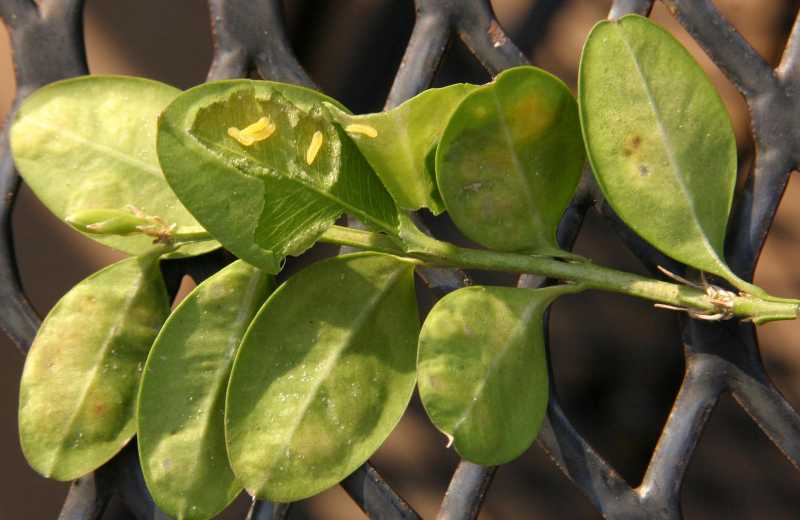Introduction
Boxwood leafminer (Monarthropalpus flavus) is a small midge that feeds on the leaves of boxwood. It is considered the most serious pest of boxwood. During its larval stage, boxwood leafminer feeds on the upper and lower portions of the plant’s leaves, causing significant blistering and discoloration.
Distribution & Habitat
Boxwood leafminer is indigenous to Europe. It was inadvertently introduced to the United States, where it has since become widely distributed. Boxwood leafminer may now be found across the entire United States.
Hosts
Boxwood leafminer consumes the leaves of American boxwood, littleleaf boxwood, and common boxwood. It may also be found on English and Japanese boxwood, albeit with less frequency. The slower growing English varieties exhibit greater resistance to the insect than the American varieties.
Description & Life Cycle
Boxwood leafminer produces one generation each year. Adult females use their ovipositor to insert eggs into the upper surfaces of leaves. The eggs hatch within 14 to 21 days, revealing masses of larvae in the form of maggots. The larvae are white, and measure up to 1/8 of an inch in length. Upon emerging, the larvae feed throughout the summer, growing all the while. As they mature, the larvae turn bright yellow. Several larvae may develop within the same leaf. The persistent feeding of the larvae induces the formation of blisters on the lower leaf surface. As temperatures cool, the larvae cease feeding and overwinter in the blisters. In early spring, as the temperatures increase, they become active, and commence feeding between the upper and lower leaves. Over time, the blisters form a thin, translucent spot called a window, which the larvae use to develop into orange pupae. Once mature, the pupae wriggle through the window, and cling to the underside of the leaf. Adult gall midges shed the pupal skin shortly thereafter. Adults are yellow to orange-red gall midges that resemble mosquitoes. Adults are approximately 0.1 inches long. The adults swarm around boxwoods in spring. As leaf expansion begins, the adults mate, and the females lay their eggs.
Effects on Trees
The larvae feed between the upper and lower parts of boxwood leaves. This causes blisters to form on the underside of the leaves. Blistering may not become apparent until late summer. Leaves infested by boxwood leafminer are often stunted, appearing smaller, and dropping prematurely. Yellow or brown splotches form on infested leaves. When boxwoods are severely infested, the leaves will become laden with blisters. Heavy infestation can result in significant defoliation, and tree mortality.
Management
- When planting, consider selecting resistant cultivars. Cultivars of English boxwood, such as Buxus sempervirens ‘Pendula’, ‘Suffruticosa’, ‘Handworthiensis’, ‘Pyramidalis’, ‘Argenteo-varigata’, and ‘Varder Valley’ exhibit an increased resistance to the insect.
- Maintain plant vigor through sound cultural practices. Ensure plants are sufficiently watered, especially during extended periods of drought. Apply a layer of organic mulch around susceptible plants to improve soil quality, moderate soil temperature, and retain soil moisture.
- Encourage the development of natural predators such as green lacewings, and spiders. This will limit the density of boxwood leafminer populations.
- Prune boxwoods before adults emerge, or just after the adults lay their eggs in May. This will help reduce leafminer populations.
- Rake and dispose of fallen leaves to reduce the potential for leafminer outbreaks.
- Insecticide applications can be administered to control leafminer populations. Begin treatment in mid-April to early May, when the adult flies can be observed hovering around boxwoods. Perform a second application in mid summer.
- Foliar systemic insecticides are effective when leafminers are present in the leaf blisters.
- Soil applications of dinotefuran or imidacloprid are effective at controlling leafminers. Dinotefuran is diffused more rapidly into the soil, allowing for faster control.
Photo courtesy of Missouri Botanical Garden.


